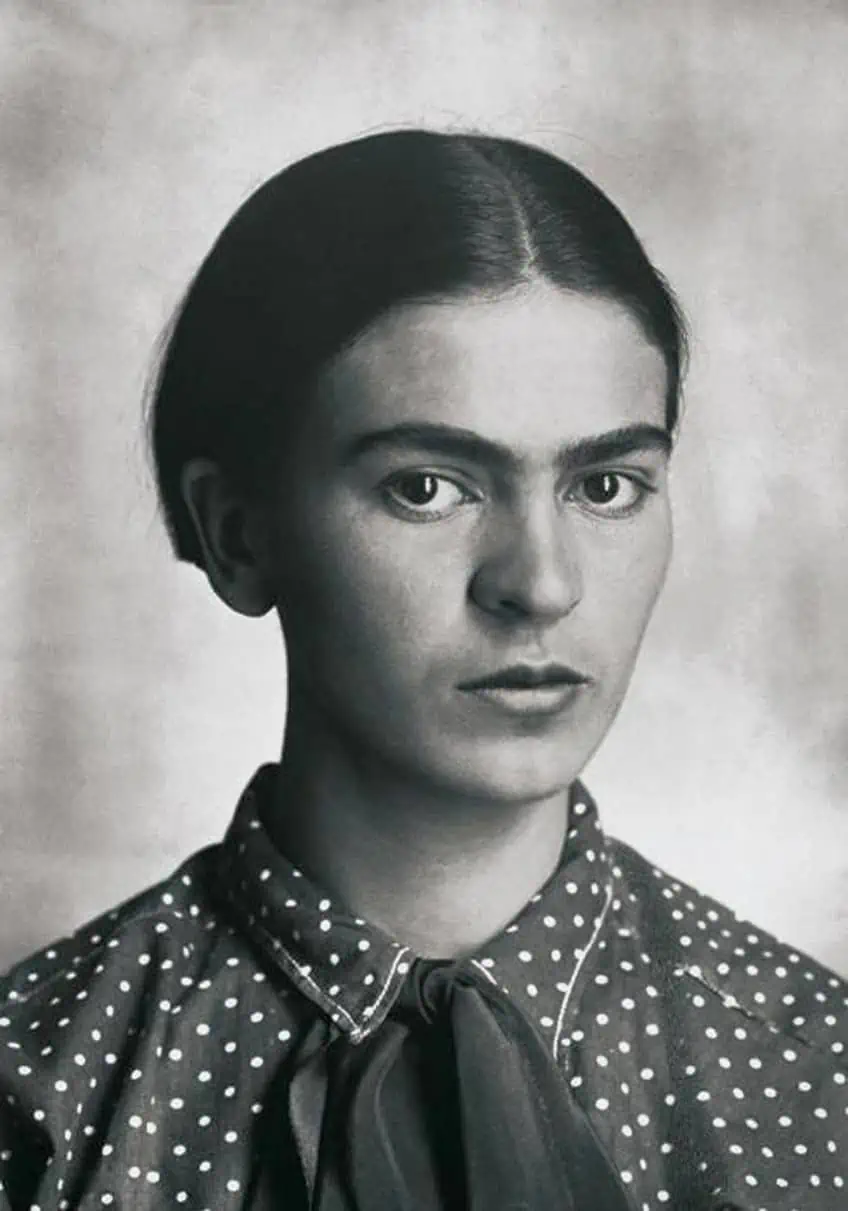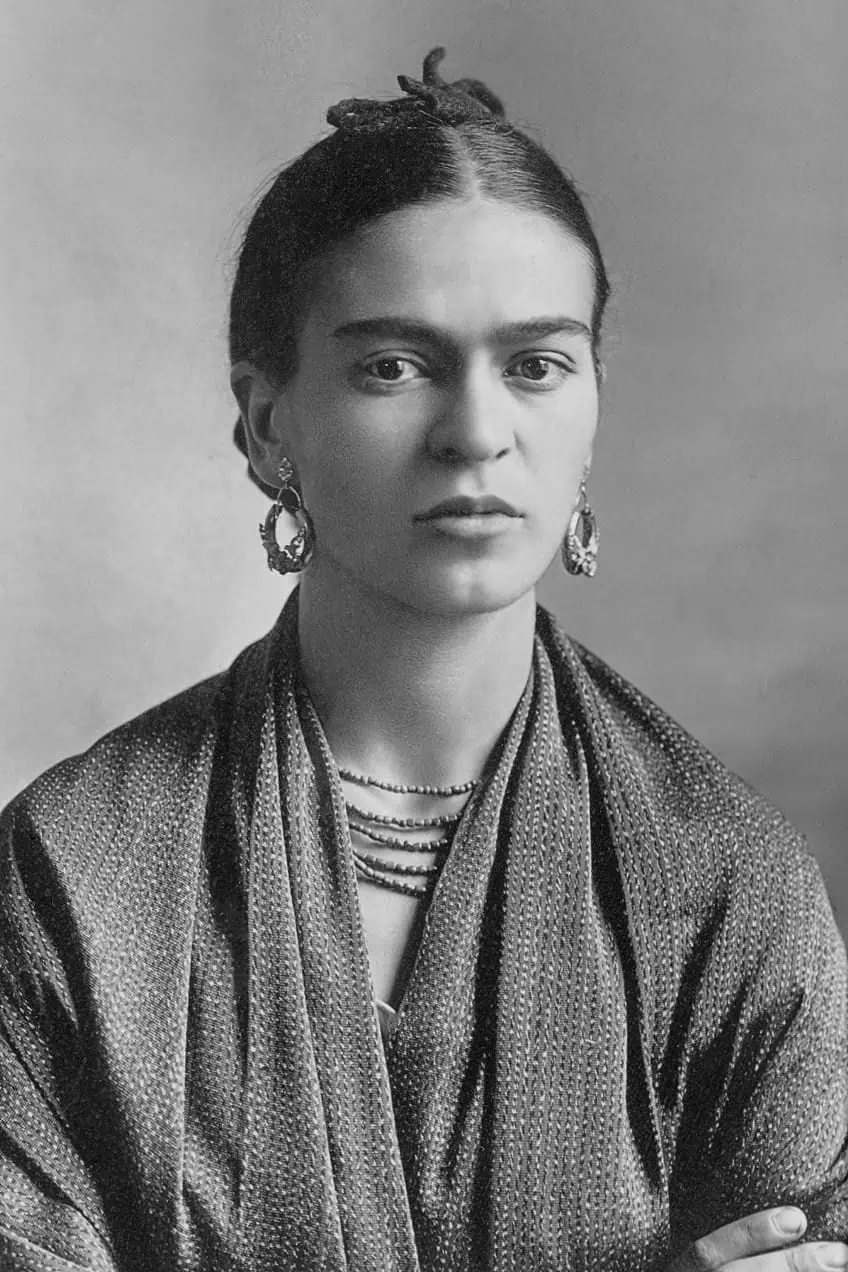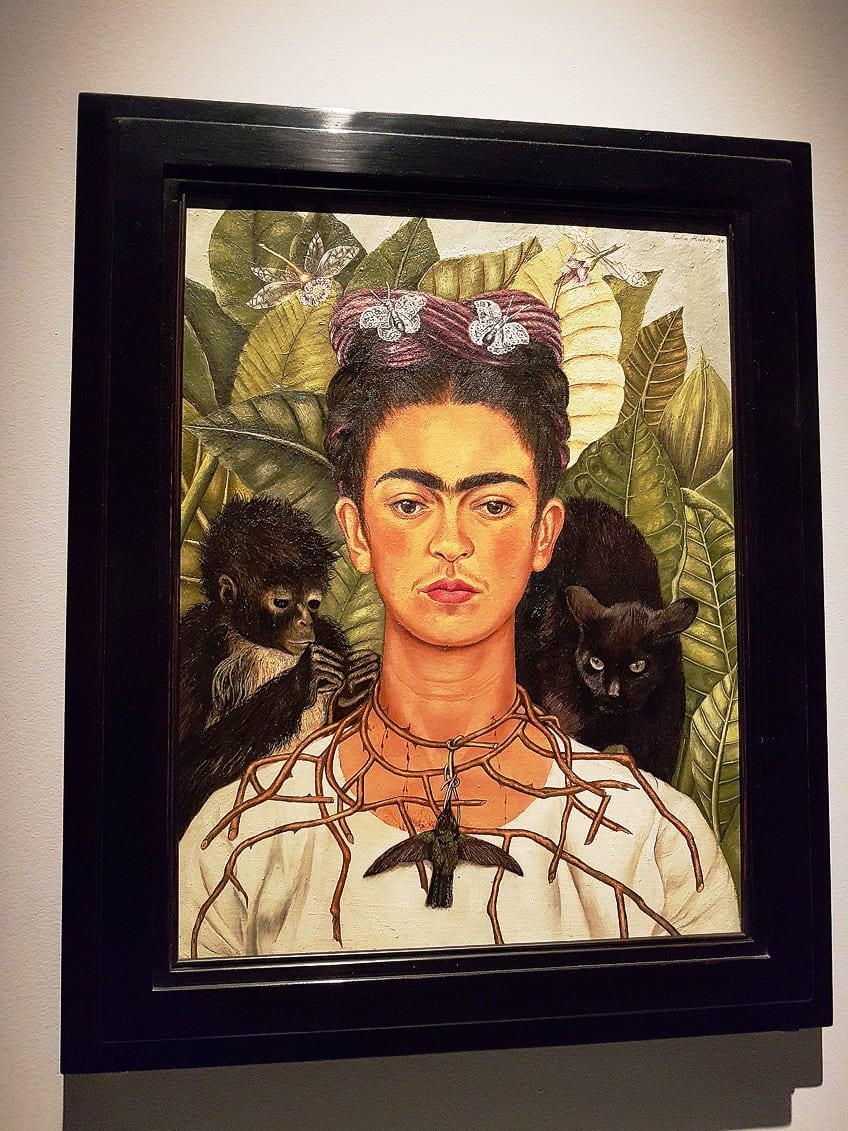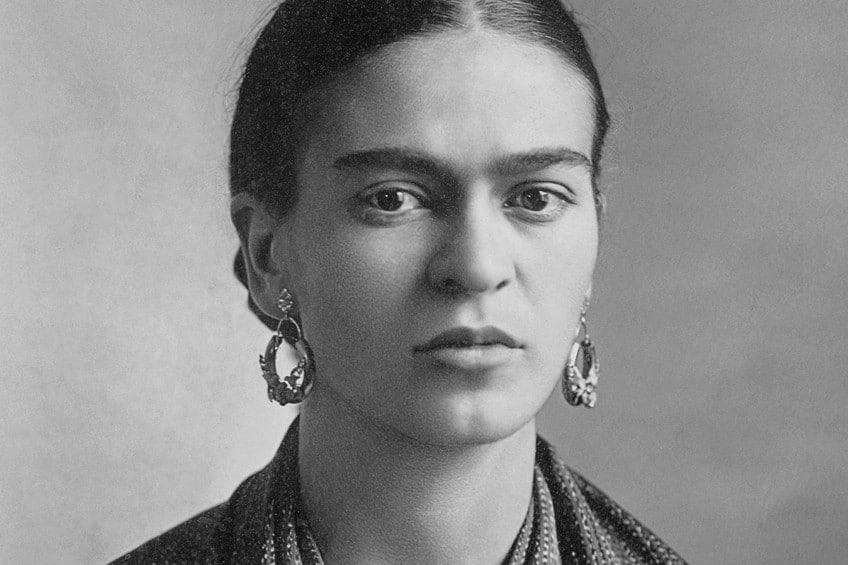“Self-Portrait with Cropped Hair” by Frida Kahlo – The Iconic Work
Self-Portrait with Cropped Hair by Frida Kahlo is one of her most recognizable artworks. It is a highly emotional painting that shows the artist’s symbolic and surrealistic style. In this article, we will complete a Self-Portrait with Cropped Hair analysis and discuss the context within which Kahlo created this striking artwork.
Contents
Artist Abstract: Who Was Frida Kahlo?
Frida Kahlo (1907 – 1954) was a Mexican painter well-known for her self-portraits and deeply emotional and symbolic works. Kahlo was born in Mexico City and she got polio when she was young. The sickness left her with a lifelong limp. In her teens, she was in a serious bus accident which left her in constant pain and unable to bear children. These physical struggles, along with her experiences of love, loss, and political upheaval, greatly influenced her art.
Kahlo’s artistic development began in the late 1920s when she began to study under the famous muralist, Diego Rivera (1886 – 1957), whom she would later marry.
Though she was mainly self-taught, she was heavily influenced by Mexican folk art, which is evident in her use of vibrant colors and bold brushstrokes. Her works often featured symbolism and surreal elements, and she often included elements of her own life and experiences in her paintings.

Kahlo’s personal life was tumultuous, marked by her stormy marriage to Rivera, her numerous affairs, and her physical suffering. Despite this, she was a strong and independent woman and an active member of the Communist Party. Kahlo’s greatest paintings include Self-Portrait with Thorn Necklace and Hummingbird (1940), The Broken Column (1944), and Frida and Diego Rivera. These works are known for their striking emotional intensity and powerful symbolism.
Kahlo’s work wasn’t widely recognized until decades after her death, but she is now considered one of the most important female artists of the 20th century and a feminist icon. Her works continue to be celebrated and inspire many artists today.
Self-Portrait with Cropped Hair by Frida Kahlo in Context
| Date | 1940 |
| Medium | Oil on masonite |
| Type of Painting | Self-portrait |
| Movement | Surrealism and Symbolism |
| Dimensions (cm) | 40 x 28 |
| Location | Museum of Modern Art, New York City, United States |
Frida Kahlo’s Self-Portrait with Cropped Hair is a powerful and deeply personal painting that provides a glimpse into the artist’s life, career, and the socio-political context in which she lived. From a young age, Kahlo was deeply affected by the political and cultural upheaval of her country. Mexico was in the midst of a revolution, and the government was actively promoting a new national identity that celebrated the country’s indigenous heritage. This cultural shift had a profound impact on Kahlo’s art, which often featured elements of Mexican folk art and was deeply rooted in her own Mexican identity.
Self-Portrait with Cropped Hair was painted in 1940 after Kahlo’s marriage to the famous muralist Diego Rivera had ended in divorce.

At this time, Frida was starting to get more recognition for her work after she had her first big sale as part of a collective exhibition at the university gallery in Mexico in 1938. André Breton (the founder of the Surrealist movement) noticed her work at this exhibition and was fascinated by the artist and her paintings. He invited her to exhibit in New York and Frida started preparations to travel with her art.
When she returned from her travels, after also finding out her Hungarian lover had found another love, Kahlo discovered that Diego had cheated on her again with her sister Cristina.
It was Diego, however, who filed for divorce, stating in his autobiography that he loved her too much to cause her so much pain and that he wanted to be free to have relationships with multiple women. Frida moved out of their shared home and was exploring her new identity without Rivera in her art. She was extremely lonely at this time and wrote in a letter to Nickolas Muray (1892 – 1965) that she was feeling rotten, helpless, and like her suffering is the worst in the world.
Self-Portrait with Cropped Hair Analysis
Self-Portrait with Cropped Hair by Frida Kahlo is a striking and powerful painting that captures the artist’s emotional restlessness and sense of loss. In this section of the article, we will do a Self-Portrait with Cropped Hair analysis by looking at the composition, color, texture, perspective, and symbol choices Kahlo made.
Compositional Overview
The composition of the painting is centered around the figure of the artist, who is depicted in the foreground with a shorn head, dressed in a man’s suit, and holding a pair of scissors. She is sitting stiffly on a yellow chair with her body turned towards the right lower corner of the painting. The background is kept minimal, with dense clouds painted behind her. Strands of her long dark hair fill the floor.
She is looking at the viewer with her usual confrontational gaze, but something about the expression on her face and eyes is communicating the helplessness and isolation Kahlo was experiencing at that time.
Subject Matter
This composition puts the focus solely on the artist, highlighting her as the main subject of the painting. The subject matter of the painting is deeply personal, as it reflects the emotional state and sense of grief that Kahlo was feeling about the failure of her marriage with Diego. The cropped hair, in particular, can be seen as a symbol of the end of her marriage to Diego Rivera, while the man’s suit suggests a rejection of traditional gender roles.
This image of a strong, self-assured woman is further emphasized by the direct gaze of the artist, who is looking directly at the viewer.
Color and Light
The color palette of the painting is limited, dominated by browns, grays, yellows, and maroons. The background of the painting is a glowing yellow, which contrasts with the dark, somber tone of the figure. This limited color palette serves to emphasize the artist’s emotional well-being and the sense of isolation that she is feeling.
The light source is coming from the upper left of the painting, casting a soft shadow on the artist’s face, creating a melancholic and contemplative mood.
Texture
The texture in the painting is created through the use of thick, impasto brushstrokes, particularly in the artist’s hair and suit. These brushstrokes add depth and dimension to the painting, and they convey a sense of movement and energy.
Perspective
The painting is a self-portrait, and the artist is represented in a frontal view. The artist is staring straight at the viewer, creating a sense of intimacy and immediacy. This frontal view is also a way of emphasizing the artist’s emotional state, as well as the symbolic elements present in the painting.
Symbolism
The symbolism in the painting is rich, and it serves to convey the artist’s emotional state and the socio-political context in which she lived. The cropped hair can be seen as a symbol of the end of her marriage, while the man’s suit suggests a rejection of traditional gender roles. The scissors in the artist’s hand can be seen as a symbol of the artist’s power to change her own life and destiny. At the top of the painting Kahlo has painted a headline reading, “If I loved you, it was because of your hair, you see. Now that you are bald, I don’t love you anymore.”
These words, the cut hair, and the man’s suit all represent Frida Kahlo severing herself from Diego. The artist takes power in changing appearance from the traditional “mother of the Mexican nation” look that pleased Diego to an androgynous independent woman.
The Development of Frida Kahlo’s Self-Portraits: A Brief Comparative Analysis
Frida Kahlo’s Self-Portrait with Cropped Hair and Self-Portrait with Thorn Necklace and Hummingbird are both self-portraits, and they share similar themes and elements, yet they are distinct in their painting techniques, symbols, and conceptual reasoning. In terms of painting techniques, both paintings employ thick, impasto brushstrokes, which add depth and dimension to the paintings and convey a sense of movement and energy.
However, the color palette of Self-Portrait with Cropped Hair is limited, with the artist’s suit and the background wall being shades of gray, while the only color present is the red of the artist’s shirt. This limited color palette serves to emphasize the artist’s emotional breakdown.

On the other hand, Self-Portrait with Thorn Necklace and Hummingbird is a representation of the lushness of nature and the vibrancy of life, with a variety of greens, blues, and reds. Both paintings share the idea of self-discovery, self-expression, and the rejection of traditional gender roles.
However, the symbols used in both paintings are different: in Self-Portrait with Cropped Hair, the scissors can be seen as a symbol of the artist’s power to change her own life and destiny, while in Self-Portrait with Thorn Necklace and Hummingbird, the hummingbird can be seen as a symbol of resilience, and the ability to find beauty amid suffering.
The clothing worn by the artist in the painting can also be seen as a statement about the role of women in Mexican society at the time. By dressing in a man’s suit, Kahlo is challenging the traditional gender roles and expectations placed on women in Mexico. She is asserting her independence and rejecting the idea that women should be confined to traditional roles.
In conclusion, Frida Kahlo’s Self-Portrait with Cropped Hair is a powerful and deeply personal painting that provides a glimpse into the artist’s life, career, and the socio-political context in which she lived. The painting reflects Kahlo’s emotional turmoil and sense of loss, as well as her rejection of traditional gender roles and her embrace of her Mexican identity. The painting continues to be celebrated for its striking emotional intensity and powerful symbolism.
Frequently Asked Questions
What Is Self-Portrait with Cropped Hair by Frida Kahlo About?
Self-Portrait with Cropped Hair is a powerful and deeply personal painting that captures Frida Kahlo’s (1907 – 1954) emotional turmoil and sense of loss. The composition, subject matter, color palette, texture, and perspective all work together to create a painting that is both striking and deeply meaningful. The symbolism in the painting serves to convey the artist’s emotional state and the socio-political context in which she lived, making it a powerful and enduring work of art.
Why Is Self-Portrait with Cropped Hair by Frida Kahlo So Influential?
Frida Kahlo’s (1907 – 1954) Self-Portrait with Cropped Hair is considered an influential artwork for several reasons. Firstly, it is a powerful self-portrait that demonstrates Kahlo’s resilience and strength in the face of personal adversity. Additionally, the painting is notable for its striking use of color and symbolism. Furthermore, the painting is considered part of the feminist art movement, as it was created at a time when most of the art was created by men and it shows a strong and independent woman. The painting is also an early example of the feminist art movement in Mexico.
Why Did Frida Kahlo Cut Her Hair?
The cropped hair in Self-Portrait with Cropped Hair can be seen as a symbol of Frida Kahlo’s (1907 – 1954) emotional state and the end of her marriage. In Mexico, long hair was traditionally associated with femininity and womanhood. By cutting off her hair, Kahlo was rejecting traditional gender roles and expressing her sense of loss and emotional turmoil.
Nicolene Burger, a South African multimedia artist and creative consultant, specializes in oil painting and performance art. She earned her BA in Visual Arts from Stellenbosch University in 2017. Nicolene’s artistic journey includes exhibitions in South Korea, participation in the 2019 ICA Live Art Workshop, and solo exhibitions. She is currently pursuing a practice-based master’s degree in theater and performance. Nicolene focuses on fostering sustainable creative practices and offers coaching sessions for fellow artists, emphasizing the profound communicative power of art for healing and connection. Nicolene writes blog posts on art history for artfilemagazine with a focus on famous artists and contemporary art.
Learn more about Nicolene Burger and about us.
Cite this Article
Nicolene, Burger, ““Self-Portrait with Cropped Hair” by Frida Kahlo – The Iconic Work.” artfilemagazine – Your Online Art Source. March 24, 2023. URL: https://artfilemagazine.com/self-portrait-with-cropped-hair-by-frida-kahlo/
Burger, N. (2023, 24 March). “Self-Portrait with Cropped Hair” by Frida Kahlo – The Iconic Work. artfilemagazine – Your Online Art Source. https://artfilemagazine.com/self-portrait-with-cropped-hair-by-frida-kahlo/
Burger, Nicolene. ““Self-Portrait with Cropped Hair” by Frida Kahlo – The Iconic Work.” artfilemagazine – Your Online Art Source, March 24, 2023. https://artfilemagazine.com/self-portrait-with-cropped-hair-by-frida-kahlo/.



